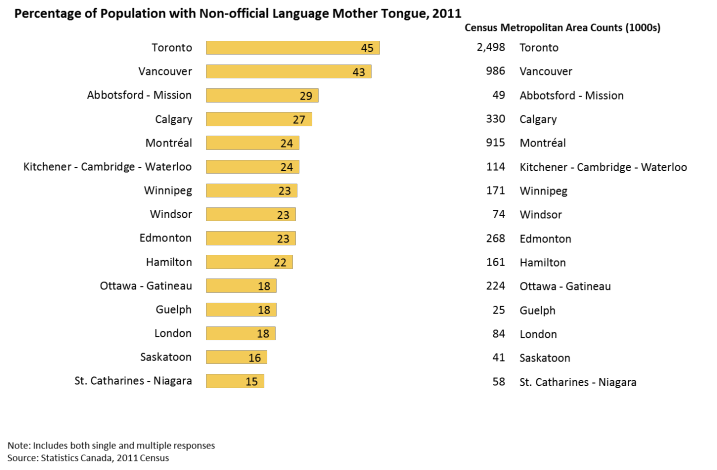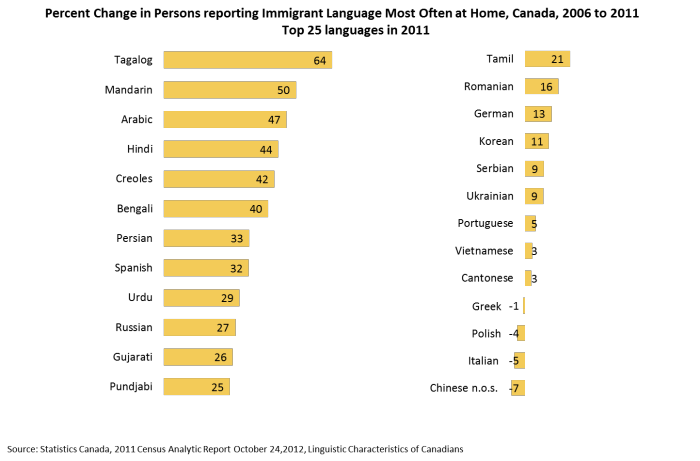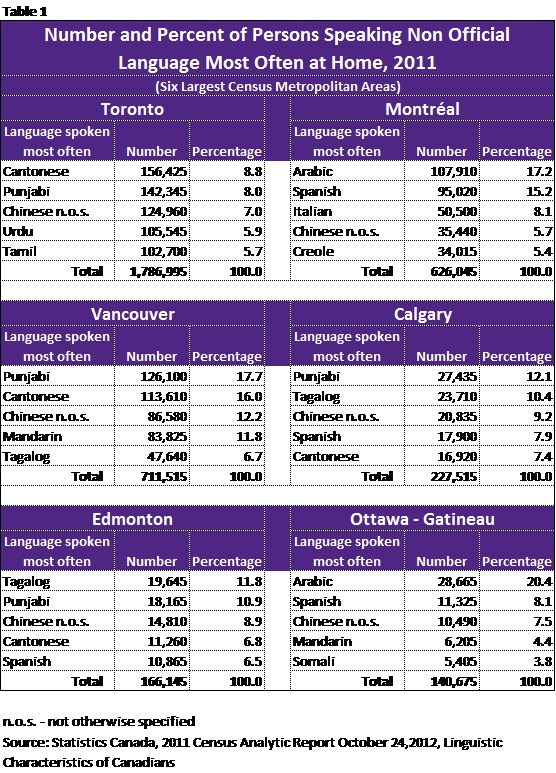Canadians Speak in Many Tongues
The data covered three main topics: 1) mother tongue or first language learned, 2) languages used at home, both most often and regularly, and 3) ability to speak English or French well enough to conduct a conversation. For the first time, the questions on home language and knowledge of official languages were asked of the entire population. For 2006, the question on mother tongue was asked on the “short form” and asked of everyone, but the other language questions were asked on the “long form” census that went to 20% of households. In addition to moving these questions, there were slight formatting changes in the questions.
When reporting the language results, Statistics Canada observed that there are “changes in patterns of response to both the mother tongue and home language questions that appear to have arisen from changes in the placement and context of the language questions on the 2011 Census questionnaire relative to previous censuses. As a result, Canadians appear to have been less inclined than in previous censuses to report languages other than English or French as their only mother tongue, and also more inclined to report multiple languages as their mother tongue and as the language used most often at home.” The agency continued with a warning: “Data users are advised to exercise caution when evaluating trends related to mother tongue and home language that compare 2011 Census data to that of previous censuses.”
In addition to the 20% sample, the long form census for 2006 and earlier was administered to only “non-institutional” residents, excluding those living in institutions such as nursing homes, jails, shelters and work camps. For the 2011 Census, all residents, including those in institutions, answered the language questions. Although Statistics Canada has made available a tabulation of mother tongue for the entire population, most of the 2011 data has been tabulated for the “non-institutional” population. So caveat emptor: this blog presents data for the non-institutional population only.
Statistics Canada has indicated they are preparing a technical report on the changes in reporting language data in 2011.
The changes in reporting patterns can be observed by looking at overall mother tongue responses for 2011 and comparing them with the 2006 responses. In 2011, 495,000 persons reported multiple mother tongues of a non-official language combined with English and/or French. This was an increase of 68% from 2006. In comparison, the increase between 2001 and 2006 was 10%. This latest high increase is no doubt due mainly to the change in response patterns between the two censuses. However, the increase in non-official mother tongues (single and multiple combined) between 2006 and 2011 is lower than expected given recent immigration patterns. .
Despite the changes in reporting patterns, the latest data still provide a good indication of the linguistic profile of Canadians today.
Mother Tongues of Canadians
Canada has always been a country of immigrants who come to our shores speaking their mother tongue and, in most cases, having some knowledge of English or French. For the 2011 Census, more than 200 languages were reported as a mother tongue or home language. As the origins of immigrants changed over the past several decades, so did the profile of languages that Canadians speak. Between the 2006 and 2011 censuses, approximately 1.3 million immigrants arrived in Canada and, based on earlier Census data, some 75% to 80% of them had a mother tongue other than English or French.
The new 2011 Census showed that 56.9% of Canadians had English as their sole mother tongue, 21.3% had French and 19.8% had a single mother tongue other than English or French. Just under 2% of the population reported multiple mother tongues, generally English and/or French in combination with another language. Overall, just over 7 million people reported having a mother tongue other than English or French, and nearly half a million people, 7% of all those reporting a non-official mother tongue, reported their non-official language in combination with English and/or French.
Among Census Metropolitan Areas, not surprisingly, Toronto and Vancouver stand out as the cities having the highest percentage of persons with a non-official language mother tongue, at 44.9% and 42.8%, respectively. These were followed by Abbotsford-Mission (29.1%) and Calgary (27.3%). Six other CMAs had above-average concentrations (21% to 25%) of persons with a non-official mother tongue: Montreal, Kitchener-Cambridge-Waterloo, Winnipeg, Windsor, Edmonton and Hamilton.

In the 2011 Census, one in five persons (6.6 million) reported speaking a language other than English or French in the home. Of these, 4.7 million (14.2% of the total population) reported speaking a non-official language most often at home, and an additional 1.9 million (5.8%) reported speaking that language on a regular basis, in addition to English or French. Overall, 4.5 million (68%) of those with a non-official home language also speak English and/or French at home. A total of 2.1 million (6.5% of the total population) do not speak either English or French at home, either most often or on a regular basis.
Between 2006 and 2011, the fastest growing home language was Tagalog (64.1%), followed by Mandarin (50.4%), Arabic (46.8%), Hindi (43.7%), and Creole (42.2%). These high growth rates reflect in large part the immigration from countries where these languages are spoken. Note that there were actual declines in Greek, Polish and Italian—the languages of older immigrants. The changes for the Chinese languages are more complicated to interpret as many Chinese immigrants indicate the language they speak is simply “Chinese”, recorded in the Census as Chinese, not otherwise stated. In 2011, there was a drop in the number of people who reported speaking a Chinese language not otherwise stated; at the same time, part of the increase in the number of those speaking Mandarin and Cantonese may be due to changes in reporting. That said, there is little doubt the increase in Mandarin users has been much larger than those speaking Cantonese since, in recent years, immigration from Mainland China has been much higher than immigration from Hong Kong.

The linguistic profile of the population, in terms of non-official languages, varies across the country and reflects immigration settlement patterns in Canada. In the Toronto CMA, 1.8 million people (32.0%) speak a non-official language most often at home. In the other largest CMAs, the tallies were 712,000 (30.8%) in Vancouver, 626,000 (16.4%) in Montreal, 227,000 (18.7%) in Calgary, 166,000 (14.3%) in Edmonton and 141,000 (11.4%) in Ottawa. The mix of languages spoken most often at home also varies, as reflected in the following table.

To simplify looking at the data by language, Statistics Canada in some cases allocates the multiple responses on language to one of three groups: English, French or Other. Using this approach, in 2011, 22.0 million persons in Canada (66.3%) reported speaking English at home on a regular basis; 7.0 million (21%) reported speaking French at home; and the remaining 4.2 million (12.6%) were speaking a non-official language most often at home. Numbers of language speakers were up for all groups but there was a slight drop in the percentages speaking English and French and a corresponding increase in the percentage speaking other languages.
In Quebec, 81.2% of the population reported speaking French most often at home, 10.7% reported English and 8.1% reported another language. In looking at the linguistic profile of Quebec, the languages spoken by those whose mother tongue is neither English nor French is always of interest. In 2011, 40% of these people spoke French, 30% spoke English and 30% spoke another language, either most often or on a regular basis. A small number (5.4%) spoke both English and French at home.
Knowledge of English and French
In 2011, there were 5.8 million Canadians (17.5%) who reported being able to conduct a conversation in both English and French. This bilingualism rate was up very slightly from 17.4% in 2006, but it fell short of the 2001 level of 17.7%. On the other hand, slightly fewer than 600,000 persons (1.8%) reported they could not speak either English or French. In the Toronto and Vancouver CMAs, 240,600 people (4.3%) and 128,460 (5.6%), respectively, could not speak English or French.
In Quebec, the English-French bilingualism rate increased from 40.6% in 2006 to 42.6% in 2011. In other provinces, bilingualism declined slightly. In Quebec, the rate was 68% among Anglophones, 38% among Francophones and 50% for those whose mother tongue was neither English nor French.
Outside Quebec, only 7% of the total Anglophone population reported being bilingual. Not surprisingly, the great majority of Francophones outside of Quebec were bilingual. For those with a non-official language mother tongue, 5% reported being able to speak both English and French and therefore were at least trilingual.
Summary
Language knowledge and use are clearly important considerations when marketers plan their communications strategy. The 2011 Census data point to an increasing number of Canadians who have a mother tongue other than English or French. Most report having a knowledge of English or French, and nearly two-thirds report using English or French at home, either most often or on a regular basis. However, 2.1 million Canadians (6.5% of the total population) do not speak English or French at home on a regular basis. Although the majority of these individuals report being able to speak either English or French, it is likely that communicating with them in one of the official languages would in some cases be problematic. In fact, even some of those who speak English or French at home on a regular basis might prefer—or at least appreciate—receiving communications in their mother tongue.
And the extent to which Canadians continue to use their non-official mother tongue languages may be an early indicator of changing notions of assimilation, national pride, regionalism, global perspective—even patriarchy, religiosity and community. These Social Values play important roles in how individuals behave in the marketplace and what messages motivate them to act.
As a result of these latest Census findings, businesses should be careful to consider Canada’s changing linguistic profile when marketing to Canadians.
###
 One of Canada’s leading experts on the Census, Doug Norris, Ph.D., is a Senior Vice President and Chief Demographer at Environics Analytics. He joined EA in 2006 after nearly 30 years with Statistics Canada, in the role as Director General of Social and Demographic Statistics. Currently, he assists companies, government agencies and not-for-profit organizations in using census and other statistical information for planning and marketing projects.
One of Canada’s leading experts on the Census, Doug Norris, Ph.D., is a Senior Vice President and Chief Demographer at Environics Analytics. He joined EA in 2006 after nearly 30 years with Statistics Canada, in the role as Director General of Social and Demographic Statistics. Currently, he assists companies, government agencies and not-for-profit organizations in using census and other statistical information for planning and marketing projects.

